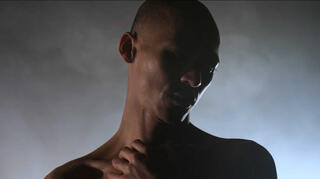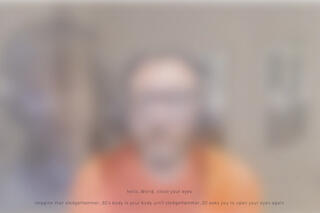Backstage with Tiran Willemse

You work as a dancer and performer – you are currently in rehearsals with Wu Tsang at Schauspielhaus Zürich. You simultaneously develop your own works and collaborate with Zurich’s Shedhalle, a space for contemporary, process-based art, as well as with others. blackmilk is your first piece under your own name, premiering at Les Urbaines in Lausanne in 2021. How did you arrive at developing your own performances?
That has been quite a long process. It developed very organically and, in a certain way, regarding a dancers’ biography, predictably, too. Still, I do not believe I have ever consciously made the decision to become a dancer or performer. That was what was available for me. I have a classical background in theatre and started dancing when I was five. Later, I constantly went to the theatre to watch ballet, or I simply trained. It is crazy to think about how much time I spent watching performances and continue training. Even still today, I train a lot and I go to the opera concerts and theatre a lot. Even if I know, I will not enjoy the piece. I do this as research, and I am very interested in the ways an audience reacts to certain situations.
I was not aware that you have such a close bond with ballet.
I contemplate a lot about the division between classical and contemporary art. I think those fields should not only exist alongside each other; they should also be more connected. In contemporary art as well as in the performing arts scene, we have important concepts of care and softness right now, and I wonder how we could transfer those ideas into a more classical environment. I believe those are gradual processes of change. It takes a long time until something new emerges. To me, training and working towards something for a long time is tender and soft. In the sense that it respects the craft. That is very important to me. In the classical performing art scene there is a sustainable structure that helps you to navigate yourself through it. When you graduate from ballet school into a company, you do not immediately go on to become a soloist. I remember us being organised into rows and it was obvious I would not be dancing in the front row but would rather find myself in the fourth or fifth. There, I learned to respect the fact that others came before me, having trained longer than I had up to that point. I find it interesting to be aware of one’s positioning within a structure, asking how one is treated as well as how one treats others. I looked up to other choreographers and dancers. I understand that classical dance and craft are being criticised, with a focus on the severity and selection processes, and I totally support that. Yet I am still deeply influenced by the discipline of classical practices, and I see potential in them.
But in blackmilk, you refer to movement material and gestures taken from contemporary music and pop culture as well as to trompoppies, drum majorettes in magnificent uniforms who perform at South African sporting events. Could you tell us more about those references and connections you are opening up during the piece?
I went to YouTube and watched Kanye West perform. And Lana Del Rey directly after that. And I went, wow. Somehow, their bodies had very similar effects on me, and I was fascinated by that. Kanye West’s performance was an explosion of things, and Lana Del Rey almost did not do a thing. But there was this resemblance, in a melancholy sense – and I could relate performatively to them both. At the same time, I was reading James Baldwin and Virginia Woolf. That was during summer 2017. I experienced the same kind of melancholia because of the way the words were structured inside their books. I was struck by these resemblances of Black masculinity to white femininity. I have been operating inside institutionalised structures ever since I went to ballet school. There, I was the only person read as male and the only Person of Colour. I became obsessed with the culture of white femininity. I wanted to be one of them, but that was never an option, because I looked different. The same goes for the trompoppies culture, wherein, traditionally, women cheer men on, men who play rugby or football. I was always told I had to do what the boys did. I was so young I did not understand. I absolutely wanted to do this. And then I started training, because I thought they would accept me if I were good enough. I trained every day for five years until I was really very good. But I could not be included in the team because I was seen as a male. Concerning access to institutions, I somehow always was confronted with a no. In my own work, I wanted this explosion. I wanted to be my own institution, determining the rules. This was the kind of protest I was interested in. blackmilk, therefore, is a hybrid of things I always wanted to be and something that has been ascribed to me. Because of my appearance, institutions today still regard me as a Black person and identify me as a man. Perhaps my approach could be compared to voguing, wherein queer and trans people of colour appropriate poses of mainly white models from Vogue magazine. To be inside one’s imagination and to fulfill one’s fantasy of what you really are.
As a title, blackmilk opens up many associations beyond that to me; it has something poetic about it. Would you like to comment on that?
I wanted to create a confrontation with this piece. So, the title needed to be imaginative in a vulgar way. Spilling milk is very vulgar. You can see it everywhere; the white somehow remains. It is a very vulgar picture when you pour black milk on institutions. In a certain way, I, too, find the piece to be vulgar, because I work with the theatre apparatus in a vulgar manner. That would serve as my reference and starting point. That was, in a certain way, my protest against those frames.
This framing – the contexts of the ‘old’ institutions – still seems so powerful, after many years of breaking them apart. What fascinates you about the stage? About the theatrical effects with light and haze, but also about the architecture of separation, of display?
I am very much interested in the theatre because I consider it my craft. The theatre is a place built for bodies and it offers the potential for bodies to be seen differently. My movement practice engages in a dialogue with the theatrical surroundings; there is the question as to how I shape my relation towards the audience and how I, in the piece, jump in between the theatre and the museum context and the frames they offer. All those frames in which things collide. In blackmilk, my playing with those frames is obvious. As I have said before, it is quite vulgar. I think a lot about what it means to perform the piece anew, and now. Now that I have spent so much time with it touring, I am somehow already on my way into another direction. So, I developed and changed the piece further, as my practice grew and mature. It is still vulgar, but much more subdued than before. I transform it to be able to still perform it, and to situate it in the respective now.
blackmilk, to me, is also an exploration of display, of exposition. How do you reflect about power in this relation?
I dedicated much research to this. I recently concluded my Master thesis in Expanded Theater at Hochschule der Künste Bern about this fascination for white femininity in theatre. Theatre was created for kings or very rich men to be entertained by female performers. I put my body in relation to the image of these female performers. I think of hysteria, melancholia, nostalgia, and how all this was inscribed into feminine bodies in the history of theatre and cinema. Feminine bodies were utilized and framed like that in front of an audience. I am very interested in this space and how to re-work these strategies. Yet what are the expectations of me inside the theatrical frame and what is my body in dialogue with, within these expectations. How do I break it all up, spontaneously catering to the audience? I want to inform and transform my audience’s reaction, so they have a different perception for the next performance; so they take on a different perspective in the theatrical frame.
Now I have to think about the impressive ending of blackmilk.
Yes, I recently wrote about this ending in an unpublished essay: “blackmilk marks a moment in my practice I began to have a different relationship with showing work. That had always been an ongoing conversation being Black in terms of survival. In my performance, I finish escorting the audience out almost one by one. The weird position of being an artist who performs. Being in the oddest position is often being in-between the class position and having that view of access. Coloniality as a form of access has always been in my work. To think about territorial expansion, the condition of violence. This dance is part of another tomorrow perhaps, another kind of language speaking things of nature, naturalness, the way it can or should be almost for me. Speaking things of Blackness, about the void, the endless void.”* I would like that to stand on its own. I do not want to explain the ending.
* For Coreia Issue #9; Coreia is an experimental, critical and discursive publication about the arts in general, with special reference to the medium of dance. Coreia is published twice a year in Portuguese and sees itself as an independent and international forum. Coreia is printed on paper and distributed free of charge in Portugal. With each new issue, the previous issue is made available online: https://www.coreia.pt/
The effect invoked by the final scene is insecurity, and if it is explained, it loses its power?
Exactly. I am concerned by questions of race, gender, and class. blackmilk represents something that once was white and could also be black. Everywhere I live, in Europe or South-Africa, I see people being segregated. These type of people live here, those type of people live there. So, when I enter the audience, I tell them I am here now. Could I go on stage and be one of those white swans in Swanlake? The answer lies in this kind of relation that is being constructed.
Most recently, you also presented blackmilk in the context of visual arts, in exhibition spaces that carry yet another charge.
The theatre is a space for spectacle – and to be honest, I love that, I am intrigued by that. Museums and galleries have a different way of dealing with time and bodies. And I am equally interested in that. I am not sure yet what exactly it will be that I am going to do at Shedhalle, if I am going to show the whole piece or only a part of it, but in a visual arts context; the options are quite open. This is not about spectacle but rather about showing one’s practice. It is also very informal in a way – that is very interesting to me as a theatre maker. It is exciting to reflect on my work in showing and through showing. It is also very interesting to develop a piece with such an abundance of theatrical effects only to omit them. During my touring of the piece a focus of mine was on sharing my physical presence and exhaustion. I wanted the audience to see me almost breaking down. I wanted to create the effect of the audience empathising strongly with me. This is very intense but beautiful.
We talked about the power of institutions a lot. Do you have a vision for a future institution?
I often contemplate the potential of people who live as ‘foreigners’ in societies, like me. They bring new ideas with them. It is a confrontation. They come from diverse contexts and know how things could run differently. I ask myself how to gather up this knowledge. I consider it an extension in a semantic manner. Rihanna is one of the most famous pop stars and originally comes from Barbados. She migrated to the US, and now she is this sensation. Such stories are important, they motivate people and show them possibilities. At the moment, I established a dance museum with my body, based on my own experiences as a performer. I really am an institution; I can build my own museum. Dance is, in fact, nothing that can possess an edifice/ a building. Dance is a practice. We carry it in our own bodies and in our own experiences.
Right now, I am reading “Ghosts of My Life: Writings on Depression, Hauntology and Lost Futures” by Mark Fisher. We previously held this romantic notion that things in the future would be like this or that in a certain way. Now we find ourselves in a time in which things and ideas simply repeat. That is the reason why, for me, my craft and experience is more important than an action on stage. I bring my experience on stage which is in dialogue with the history of performance and theatre and ask how can this be more sustainable? In the face of the climate crisis, it is rather crazy to start one’s own works, to develop pieces. We do not know what will happen to us. How can we, under these conditions, create a work that can be reproduced, that can succeed?
blackmilk has been announced as the first part of a trilogy. What will happen next?
I work in a non-linear and organic manner. Somehow, I am almost done with the trilogy, but I do not believe that now is the time to produce it. That responds to what I just described. I think a lot about what happens in the world around me and how I am being influenced by those things. Now is not the right moment for the second and third part of the trompoppies trilogy. Maybe I will spend the next ten years ‘sitting’ on those works, carrying them with me instead of realising them. My focus lies on what is happening right now, and on the issues expressed in blackmilk. Those are interesting things that need to be more intensely researched. And that needs to happen now because this is the right point in time for that. Only with time did blackmilk become its very own thing. Moreover, I need resources to realise the next two instalments in the trilogy – a production’s time frame always corresponds to the means and feasibilities, too.
Thank you for your time and for sharing your thoughts.
For blackmilk, Tiran Willemse was awarded the Performance Prize Switzerland 2023. “The jury was impressed by the physical presence, precision and elaborateness of Tiran Willemse's choreography. Willemse succeeds in building up an arc of tension over ninety minutes in which the audience was actively involved. [...] Tiran Willemse negotiates masculinity in a sensitive way. Willemse creates an own identification figure, which is characterised by tenderness and vulnerability.”
Born in South Africa, Willemse lives in Berlin and Zurich and works both in dance and choreography. Willemse's work is based on a careful observation of space, imagination, gesture and sound. A focus of the work is the examination of practices of performance, communication and questioning the relationship between race and gender. Willemse collaborated with Trajal Harrell, Jérôme Bel, Meg Stuart, Ligia Lewis and Eszter Salamon, among others.
The questions were posed by Lucie Ortmann.





